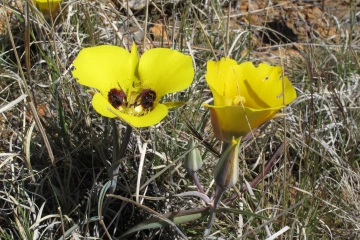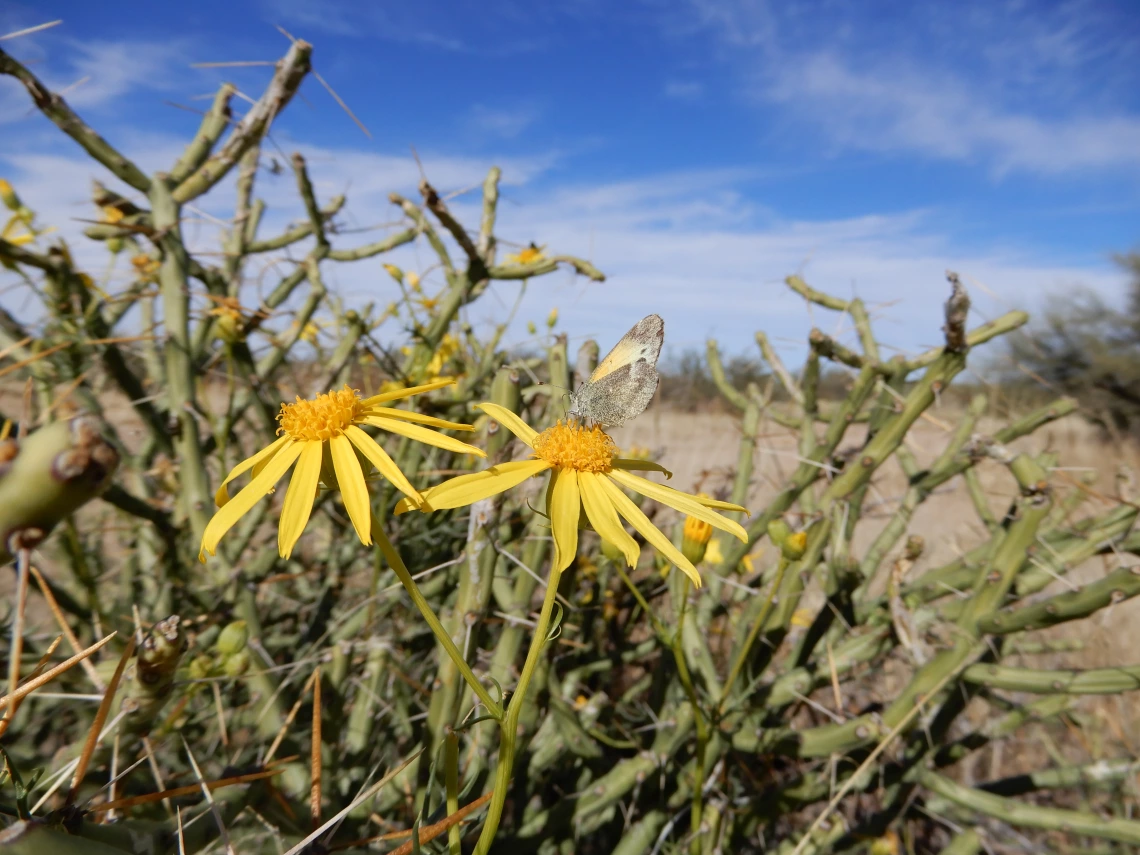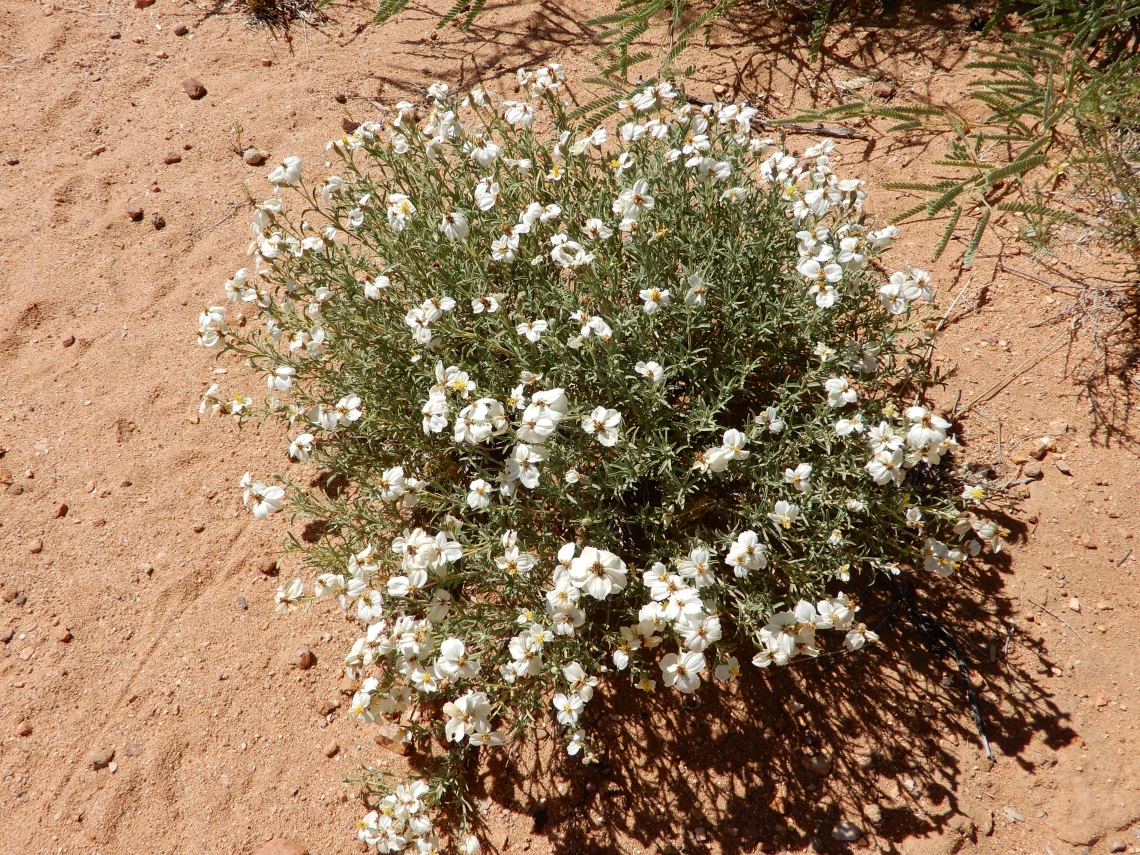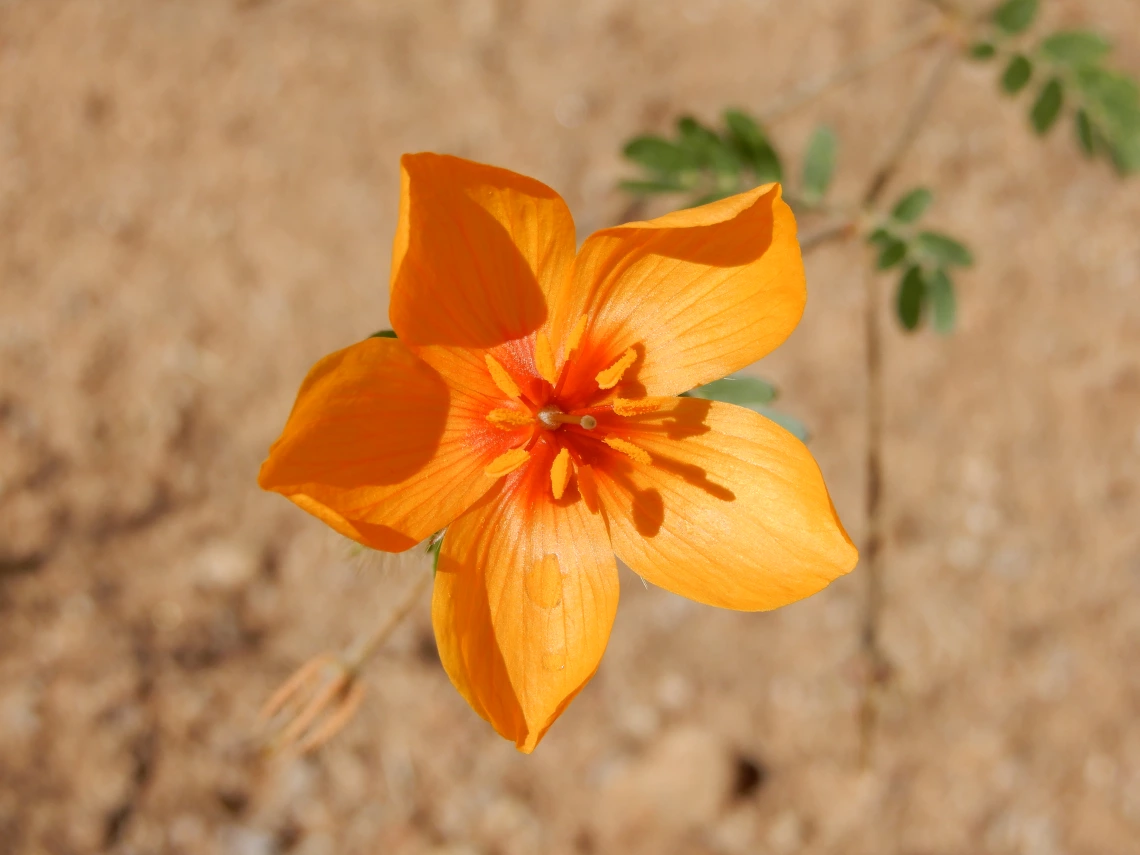
Desert Mariposa Lily (Calochortus kennedyi)
The Flora database provides access to resources and information about the plants species found on the Santa Rita Experimental Range (SRER). According to the most recent inventory (Medina 2003), the vascular flora of the SRER accounts for 468 species, divided into 283 genera and 80 families. The three largest families are Poaceae, Asteraceae, and Fabaceae, which account for 45 percent of the total flora.
Within the Poaceae family, the most common species are native grasses such as Rothrock grama (Bouteloua rothrockii Vasey), sideoats grama (B. curtipendula (Michx.) Torr.), Arizona cottontop (Digitaria californica (Benth.) Henrard), bush muhly (Muhlenbergia porteri Scribn.), tanglehead (Heteropogon contortus (L.) Beauv.), several threeawn species (Aristida spp.), and the nonnative Lehmann lovegrass (Eragrostis lehmanniana Nees). Most common Asteraceae species are burroweed (Haplopappus tenuisectus (Greene) Blake), snakeweed (Gutierrezia sarothrae (Pursh.), and desert broom (Baccharis sarothroides). Fabaceae family includes mainly shrubs and trees such as catclaw acacia (Acacia greggii A. Gray), Fairy-Duster (Calliandra eriophylla Benth.), wait-a-minute bush (Mimosa aculeaticarpa var. biuncifera (Benth.) Barneby), velvet-pod mimosa (Mimosa dysocarpa Benth.), blue paloverde (Cercidium floridum Benth.), and velvet mesquite (Prosopis velutina Woot.). Other common plant species on the Santa Rita are prickly pear (Opuntia spp. Mill.), fishhook barrel (Ferocactus wislizenii (Engelm) Britt. & Rose), and cholla (Cylindropuntia spp.) cacti (Cactaceae), soaptree yucca (Yucca elata Engelm.) (Asparagaceae), ocotillo (Fouquieria spp.) (Fouquieriaceae), and desert hackberry (Celtis pallida Torr.) (Cannabaceae).
Below, we provide Medina's inventory as well as updates to the SRER Flora based on the field studies conducted on the SRER. Specifically:
- The database listing all plant species identified on the Ongoing Vegetation Transects, Exclosure Transects, and August Photo Stations;
- The database listing all plant species recorded annually while taking Repeat Photography on the August Photo Stations.
Updates to the SRER Flora are given by checking the presence or absence in Medina’s list and the presence or absence of specimens collected on the SRER and registered in the SEINet database for all species listed in the databases.
References
Medina, Alvin L. 2003. Historical and Recent Flora of the Santa Rita Experimental Range. In: McClaran, Mitchel P.; Ffolliott, Peter F.; Edminster, Carleton B., tech. coords. Santa Rita Experimental Range: 100 years (1903 to 2003) of accomplishments and contributions; conference proceedings; 2003 October 30–November 1; Tucson, AZ. Proc. RMRS-P-30. Ogden, UT: U.S. Department of Agriculture, Forest Service, Rocky Mountain Research Station. p. 157-165.
SEINet Portal 2024. https://swbiodiversity.org/seinet/
Medina's flora (2003) is the most comprehensive and recent inventory of plant species of the SRER. It was composed by using historical lists and data from more recent studies conducted on the range over the years. The original paper is part of the Proceedings from the Centennial Conference 2003 "Santa Rita Experimental Range: 100 years (1903 to 2003) of accomplishments and contributions" and is available below for download. The first inventory of the flora of the SRER (Medina 1996) is also available on this website as Appendix C of the Annotated Bibliography (1903 - 1988).
Because Species, Genus, and Family names for plants are frequently revised, we suggest referring to the SEINet Data Portal to check nomenclature changes for the species listed in these inventories.
The plant species inventory available below for download includes the complete list of plant species identified while conducting the Ongoing Vegetation Transects, the Exclosure Transects, and the August Repeat Photography floristic recordings on the SRER.
For each species, the database provides:
- Scientific name, current synonyms, and code
- Source (vegetation transect or photo station)
- Presence or absence in Medina’s list
- Presence or absence of specimens collected on the SRER and registered in the SEINet database
- Botanical family
- Life cycle
- Life form category
In the database, plant species are registered with the historical plant name used on the SRER or the currently accepted synonyms according to the SEINet Data Portal. Because Species, Genus, and Family names for plants are frequently revised, we suggest referring to the SEINet Data Portal for further details and updates on nomenclature changes.
A comprehensive list of all plant species found at each August Photo Station is available below for download. Recordings started in August 2024 on 18 Photo Stations (14 existing and 4 new) to document species richness and vegetation changes after each monsoon season. Photos and floristic recordings will be repeated annually.
For each Photo Station, the database lists all annual and perennial plant species recorded within a 40 m² plot in front of the camera. Floristic plots start 2 m from the camera and end 8 m from the camera, while right and left boundaries follow the right and left edges of the camera view.
For each species, the database provides:
- Scientific name, current synonyms, and code
- Presence or absence in Medina’s list
- Presence or absence of specimens collected on the SRER and registered in the SEINet database
- Botanical family
- Life cycle
- Life form category
As indicated above, Medina's Flora (2003) is currently under revision and the updates will be provided on this page. The new list will include the new plant species identified on the SRER while conducting research activities (for instance, Encelia frutescens, Euphorbia serpillifolia, and Euphorbia polycarpa) and all the plant species collected on the SRER and already registered in the SEINet database.
The next updates will also include some non-native grasses that have been found in the range, such as Pennisetum ciliare (Buffelgrass), Melinis repens (Natalgrass), Enneapogon cenchroides (Softfeather Pappusgrass), and Fingerhuthia africana (Thimblegrass).





